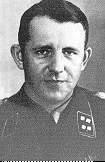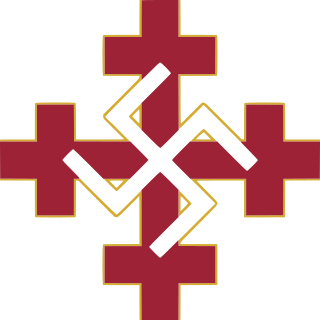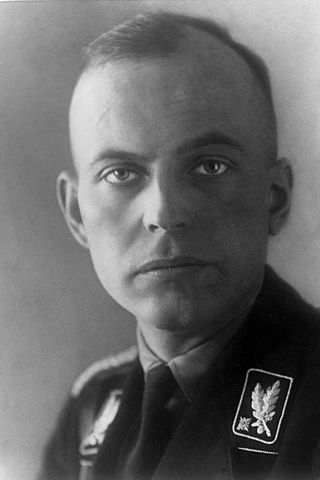Related Research Articles

Rudolf Lange was a German SS functionary and police official during the Nazi era. With the invasion of the Soviet Union, he served in Einsatzgruppe A before becoming a commander in the Sicherheitsdienst (SD) and all RSHA personnel in Riga, Latvia. He participated in the January 1942 Wannsee Conference, at which the genocidal Final Solution to the Jewish Question was planned, and was largely responsible for implementing the murder of Latvia's Jewish population during the Holocaust.

Pērkonkrusts was a Latvian ultranationalist, anti-German, anti-Slavic, and antisemitic political party founded in 1933 by Gustavs Celmiņš, borrowing elements of German nationalism—but being unsympathetic to Nazism at the time—and Italian Fascism. It was outlawed in 1934, its leadership arrested, and Celmiņš eventually exiled in 1937. Still-imprisoned members were persecuted under the first Soviet occupation; some collaborated with subsequently invading Nazi Germany forces in perpetrating the Holocaust. Pērkonkrusts continued to exist in some form until 1944, when Celmiņš, who had initially returned to work in the occupying German administration, was imprisoned.
The ArajsKommando, led by SS commander and Nazi collaborator Viktors Arājs, was a unit of Latvian Auxiliary Police subordinated to the German Sicherheitsdienst (SD). It was a notorious killing unit during the Holocaust.

Friedrich Jeckeln was a German SS commander during the Nazi era. He served as a Higher SS and Police Leader in the occupied Soviet Union during World War II. Jeckeln was the commander of one of the largest collection of Einsatzgruppen death squads and was personally responsible for ordering and organising the deaths of over 100,000 Jews, Romani and others designated by the Nazis as "undesirables". After the end of World War II in Europe, Jeckeln was convicted of war crimes by a Soviet military tribunal in Riga and executed in 1946.

Herberts Cukurs was a Latvian aviator and deputy commander of the Arajs Kommando, which carried out the largest mass murders of Latvian Jews in the Holocaust. Although Cukurs never stood trial, the accounts of multiple Holocaust survivors, including Zelma Shepshelovitz, credibly link him to war crimes and crimes against humanity.

Hans-Adolf Prützmann was among the highest-ranking German SS officials during the Nazi era. From June 1941 to September 1944, he served as a Higher SS and Police Leader in the occupied Soviet Union, and from November 1943 was the Supreme SS and Police Leader in Ukraine. He oversaw the activities of the Einsatzgruppen detachments that perpetrated the Holocaust in the Baltic States and Ukraine. After being captured at the end of the Second World War, he committed suicide.

The military occupation of Latvia by Nazi Germany was completed on July 10, 1941 by Germany's armed forces. Initially, the territory of Latvia was under the military administration of Army Group North, but on 25 July 1941, Latvia was incorporated as Generalbezirk Lettland, subordinated to Reichskommissariat Ostland, an administrative subdivision of Nazi Germany. Anyone not racially acceptable or who opposed the German occupation, as well as those who had cooperated with the Soviet Union, were killed or sent to concentration camps in accordance with the Nazi Generalplan Ost.

The Latvian Legion was a formation of the German Waffen-SS during World War II. Created in 1943, it consisted primarily of ethnic Latvian personnel. The legion consisted of two divisions of the Waffen-SS: the 15th Waffen Grenadier Division of the SS, and the 19th Waffen Grenadier Division of the SS. The 15th Division was administratively subordinated to the VI SS Corps, but operationally it was in reserve or at the disposal of the XXXXIII Army Corps, 16th Army, Army Group North. The 19th Division held out in the Courland Pocket until May 1945, the close of World War II, when it was among the last of Nazi Germany's forces to surrender.

The Rumbula massacre is a collective term for incidents on November 30 and December 8, 1941, in which about 25,000 Jews were murdered in or on the way to Rumbula forest near Riga, Latvia, during World War II. Except for the Babi Yar massacre in Ukraine, this was the biggest two-day Holocaust atrocity until the operation of the death camps. About 24,000 of the victims were Latvian Jews from the Riga Ghetto and approximately 1,000 were German Jews transported to the forest by train. The Rumbula massacre was carried out by the Nazi Einsatzgruppe A with the help of local collaborators of the Arajs Kommando, with support from other such Latvian auxiliaries. In charge of the operation was Höherer SS und Polizeiführer Friedrich Jeckeln, who had previously overseen similar massacres in Ukraine. Rudolf Lange, who later participated in the Wannsee Conference, also took part in organizing the massacre. Some of the accusations against Latvian Herberts Cukurs are related to the clearing of the Riga Ghetto by the Arajs Kommando. The Rumbula killings, together with many others, formed the basis of the post-World War II Einsatzgruppen trial where a number of Einsatzgruppen commanders were found guilty of crimes against humanity.

The Holocaust in Latvia refers to the crimes against humanity committed by Nazi Germany and collaborators victimizing Jews during the occupation of Latvia. From 1941 to 1944, around 70,000 Jews were murdered, approximately three-quarters of the pre-war total of 93,000. In addition, thousands of German and Austrian Jews were deported to the Riga Ghetto.
RollkommandoHamann was a small mobile unit that committed mass murders of Lithuanian Jews in the countryside in July–October 1941, with an estimated death toll of at least 60,000 Jews. The unit was also responsible for many murders in Latvia from July through August 1941. At the end of 1941 the destruction of Lithuanian Jewry was effectively accomplished by Hamann's unit in the countryside, by the Ypatingasis būrys in the Ponary massacre, and by the Tautinio Darbo Apsaugos Batalionas (TDA) in the Ninth Fort in Kaunas. In about six months an estimated 80% of all Lithuanian Jews were killed. The remaining few were spared for use as a labor force and concentrated in urban ghettos, mainly the Vilna and Kaunas Ghettos.
The Jelgava massacres were the killing of the Jewish population of the city of Jelgava, Latvia that occurred in the second half of July or in early August 1941. The murders were carried out by German police units under the command of Alfred Becu, with a significant contribution by Latvian auxiliary police organized by Mārtiņš Vagulāns.
Wolfgang Kügler was an SS-Untersturmführer and a Teilkommandoführer for Einsatzkommando 2, a subdivision of Einsatzgruppe A. Following World War II, he was tried and found guilty of war crimes before a court in West Germany. His sentence was reported to have been 8 months in prison and a fine. The most serious charge against him was that he had organized and been a commander at the massacre of about 2,700 Jews, mostly women and children, on the beach at Liepāja, Latvia. Kügler claimed he was absent on leave in Germany when these murders occurred. After being re-arrested in 1959, Kügler killed himself in prison.

Fritz Maria Josef Dietrich was an Austrian SS officer and member of the Nazi Party. He held a doctoral degree in chemistry and physics. His name is also seen as Emil Dietrich. After the war, he was put on trial as a war criminal for ordering the killings of 7 American POWs, found guilty, and executed.

The Liepāja massacres were a series of mass executions, many public or semi-public, in and near the city of Liepāja, on the west coast of Latvia in 1941 after the German occupation of Latvia. The main perpetrators were detachments of the Einsatzgruppen, the Sicherheitsdienst (SD), the Ordnungspolizei (ORPO), and Latvian auxiliary police and militia forces. Wehrmacht soldiers and German naval personnel were present during shootings. In addition to Jewish men, women and children (c.5,000), the Germans and their Latvian collaborators also killed Roma (c.100), communists, the mentally ill (c.30) and so-called "hostages". In contrast to most other Holocaust murders in Latvia, the killings at Liepāja were done in open places. About 5,000 of the 5,700 Jews trapped in Liepāja were shot, most of them in 1941. The killings occurred at a variety of places within and outside of the city, including Rainis Park in the city center, and areas near the harbor, the Olympic Stadium, and the lighthouse. The largest massacre, of 2,731 Jews and 23 communists, occurred in the dunes surrounding the town of Šķēde, north of the city center. This massacre, which was perpetrated on a disused Latvian Army training ground, was conducted by German and collaborator forces from December 15 to 17, 1941. More is known about the killing of the Jews of Liepāja than in any other city in Latvia except for Riga.
The Dünamünde Action was an operation launched by the Nazi German occupying force and local collaborationists in Biķernieki forest, near Riga, Latvia. Its objective was to execute Jews who had recently been deported to Latvia from Germany, Austria, Bohemia and Moravia. These murders are sometimes separated into the First Dünamünde Action, occurring on March 15, 1942, and the Second Dünamünde Action on March 26, 1942. About 1,900 people were killed in the first action and 1,840 in the second. The victims were lured to their deaths by a false promise that they would receive easier work at a (non-existent) resettlement facility near a former neighbourhood in Latvia called Daugavgrīva (Dünamünde). Rather than being transported to a new facility, they were trucked to woods north of Riga, shot, and buried in previously dug mass graves. The elderly, the sick and children predominated among the victims.

The burning of the Riga synagogues occurred in 1941, during the first days of the World War II Nazi German occupation of the city of Riga, the capital and largest city in the country of Latvia. Many Jews confined in the synagogues died in the fires. Many other anti-Semitic measures were launched at the same time, ultimately followed by the murder of the vast majority of the Jews of Latvia.

Biķernieki Memorial is a war memorial to the Holocaust victims of World War II in Biķernieki forest in Riga, Latvia. Biķernieki forest is the biggest mass murder site during the Holocaust in Latvia with two memorial territories spanning over 80,000 square metres (860,000 sq ft) with 55 marked burial sites with around 20,000 victims still buried in total.
David Silberman is a writer, researcher and a Jewish activist who, having escaped death when the Germans invaded Latvia, gathered and published facts, testimony and documents from survivors of the Holocaust living in Latvia in the 1960s. He had several works published on that theme. Silberman lives in New York, is a US citizen and works as a consultant engineer.
Joachim Hamann was an officer of the Einsatzkommando 3, a killing unit of Einsatzgruppe A, responsible for tens of thousands of Jewish deaths in Lithuania. Hamann organized and commanded Rollkommando Hamann, a small mobile killing unit composed of 8–10 Germans and several dozen local Lithuanian collaborators.
References
- ↑ "RIP Andrievs Ezergailis, renowned Latvian historian and long-time member of AABS". Association for the Advancement of Baltic Studies. 27 January 2022. Retrieved 28 March 2022.
- 1 2 "Ezergailis Honored by Latvia", Ithaca College Quarterly , April 2006